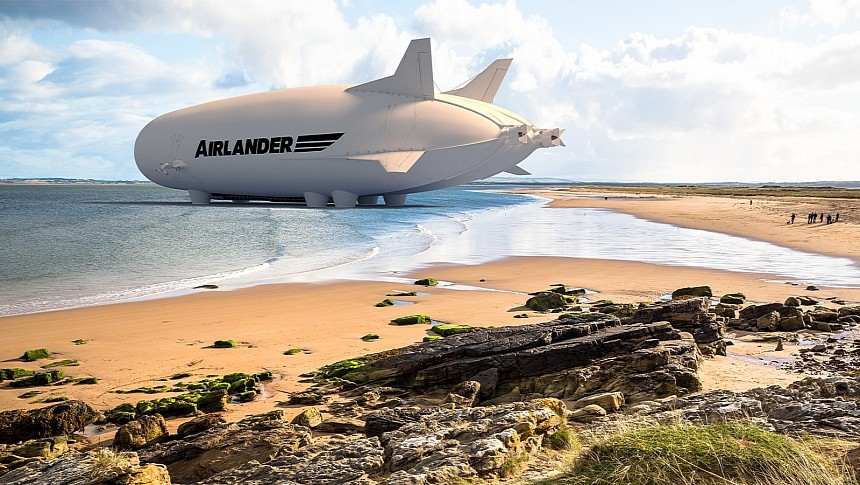The infamous Airlander 10 could play a major role in advancing sustainable air mobility for the island communities in the north of Scotland. This is the conclusion of a complex concept study focusing on the particularities of this region and their compatibility with this innovative aircraft.
Scotland is aiming for net zero regional air transport by the end of the next decade. At the same time, inter-island connectivity and harsh weather conditions are far more challenging in terms of efficient transport compared to other regions. Airlander 10 could address both of these angles effectively due to its low cost, high payload, low emission footprint, and operational flexibility.
Despite its enormous size and atypical shape, the Airlander 10 is surprisingly versatile. It can withstand difficult weather conditions and can be deployed from different types of small airports, island airfields, and even sheltered bodies of water. In terms of capacity, it's designed to carry up to ten tonnes (11 tons) or 100 passengers, and it does so with low emissions.
It does require certain modifications to existing infrastructure, but they wouldn't be too complex or expensive. The concept study analyzed six airfields in the Highlands and Islands of Scotland and found that adapting them for the Airlander 10 would cost less than £2 million ($2.4 million).
The same study found that adding the Airlander to the region's air mobility system could increase its air freight capacity by 79% compared to 2021, translating to nearly 45,000 tons. In other words, people living in these communities could enjoy better access to all kinds of goods and services in a shorter time, thanks to this huge aircraft. And the benefits wouldn't be limited to logistics but also include other sectors, such as regional tourism.
These are some of the main findings of a recent report co-founded by the UK government. The funding was provided for the SATE (Sustainable Aviation Test Environment), with HAV (Hybrid Air Vehicles ) being one of the partners. For this research, a team of engineers conducted on-site surveys at seven locations across the region, focusing on the existing infrastructure, local weather data, and their compatibility with the operational requirements for the Airlander 10.
Despite its futuristic design, this unusual alternative to regional aircraft has the potential to bring fast and major changes to the current air mobility system in the Scottish Highlands, and it might be easier to integrate than some would think.
It looks like HAV is getting closer to bringing its revolutionary concept to the market. At the beginning of the year, the UK-based company confirmed it was setting up an official production line in South Yorkshire, with an estimated capacity of 12 Airlander units per year. Plus, its main customer so far, Air Nostrum, doubled the initial pre-order, which will help speed up the development and certification process for the famous "Flying Bum."
Despite its enormous size and atypical shape, the Airlander 10 is surprisingly versatile. It can withstand difficult weather conditions and can be deployed from different types of small airports, island airfields, and even sheltered bodies of water. In terms of capacity, it's designed to carry up to ten tonnes (11 tons) or 100 passengers, and it does so with low emissions.
It does require certain modifications to existing infrastructure, but they wouldn't be too complex or expensive. The concept study analyzed six airfields in the Highlands and Islands of Scotland and found that adapting them for the Airlander 10 would cost less than £2 million ($2.4 million).
The same study found that adding the Airlander to the region's air mobility system could increase its air freight capacity by 79% compared to 2021, translating to nearly 45,000 tons. In other words, people living in these communities could enjoy better access to all kinds of goods and services in a shorter time, thanks to this huge aircraft. And the benefits wouldn't be limited to logistics but also include other sectors, such as regional tourism.
These are some of the main findings of a recent report co-founded by the UK government. The funding was provided for the SATE (Sustainable Aviation Test Environment), with HAV (Hybrid Air Vehicles ) being one of the partners. For this research, a team of engineers conducted on-site surveys at seven locations across the region, focusing on the existing infrastructure, local weather data, and their compatibility with the operational requirements for the Airlander 10.
Despite its futuristic design, this unusual alternative to regional aircraft has the potential to bring fast and major changes to the current air mobility system in the Scottish Highlands, and it might be easier to integrate than some would think.
It looks like HAV is getting closer to bringing its revolutionary concept to the market. At the beginning of the year, the UK-based company confirmed it was setting up an official production line in South Yorkshire, with an estimated capacity of 12 Airlander units per year. Plus, its main customer so far, Air Nostrum, doubled the initial pre-order, which will help speed up the development and certification process for the famous "Flying Bum."







